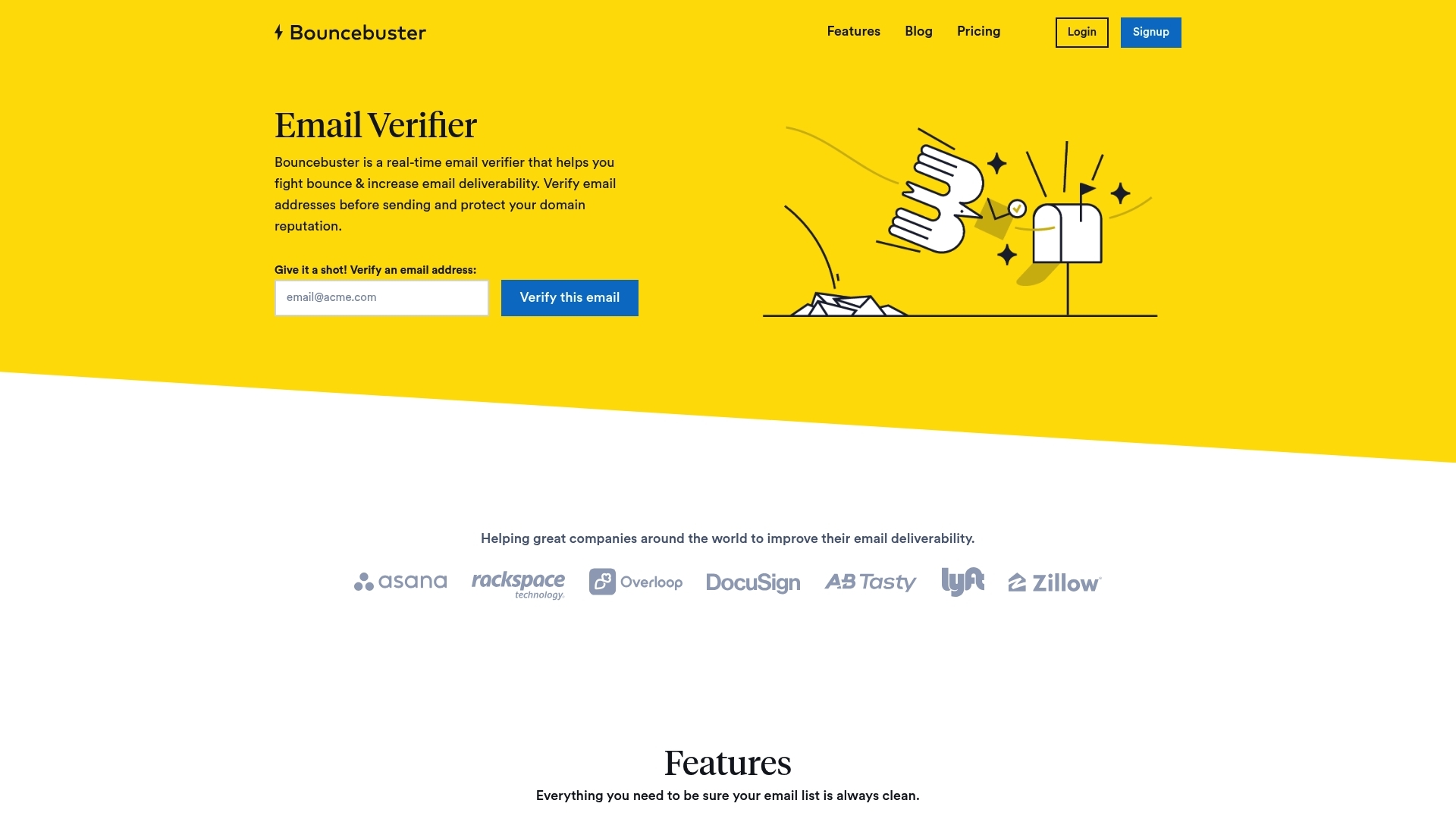How to Choose the Right Email Verifier for Your Business in 2025
An effective email verifier has become essential for any business aiming to reduce bounce rates, improve deliverability, and protect sender reputation. The landscape for email marketing in 2025 requires tools that go beyond simple checks; businesses need solutions that process bulk lists quickly, perform precise manual verifications, and connect seamlessly with platforms like Mailchimp or Salesforce.
What to Expect From This Guide
This guide provides a straightforward process to help you choose the best email verifier for businesses in 2025:
- Understand why ongoing email list cleaning matters for campaign success.
- See which features—like API access, CRM integrations, and real-time checks—make a difference for growing companies.
- Follow clear steps to evaluate, test, and compare options for both small teams and large organizations.
- Find out how tools such as Bouncebuster support bulk and manual list cleaning, making it easier to maintain accuracy.
- Access actionable tips for keeping your lists fresh and your emails landing where they should.
By following this guide, you can make informed decisions that save time, maintain high deliverability, and ensure you get the best results from your email marketing efforts in 2025.
Why Every Business Needs an Email Verifier in 2025
Email marketing remains a vital channel for businesses in 2025, but its challenges continue to evolve. Most companies manage large email lists gathered from multiple sources—some reliable, others outdated or unverified. Campaigns sent to invalid, duplicate, or spam-trap addresses often trigger high bounce rates, hurt sender reputation, and lower overall deliverability. With stricter spam filters and advanced fraud detection systems in place, ISPs penalize senders faster than ever for bad data.
Consequences of Unverified Email Lists
Failing to maintain a verified list can lead to:
- Increased bounce rates, which signal poor sender health to mailbox providers
- Messages landing in spam folders or being blocked outright
- Wasted budget on email campaigns that never reach real people
- Diminished engagement, open rates, and conversions
Email verification services address these risks by validating email addresses before messages are sent. They check for syntax errors, detect disposable emails, and confirm mailboxes exist—all essential to keep lists healthy and campaigns effective. For businesses that rely on frequent outreach, using a reliable email verifier means more messages are delivered to the inbox, boosting results and securing long-term marketing ROI.
Platforms like Bouncebuster simplify this process with features such as bulk verification, real-time checks, and integration options that fit directly into your workflow. By regularly cleaning lists, businesses can protect sender reputation and ensure every campaign starts with a solid foundation of valid contacts.
Key Features to Look for in an Email Verifier
Finding the right email verifier in 2025 means knowing which features directly improve your results. A good verifier balances advanced functionality with ease of use, making your email marketing more effective and efficient.
Bulk Email Verification for Efficient List Cleaning
Businesses often manage thousands of addresses at once. Bulk verification lets you upload entire lists and receive feedback on every address’s validity in a single process. This saves time and ensures you can act quickly on your results. Platforms like Bouncebuster make large list uploads simple, letting you work with formats such as CSV or XLS.
Manual and Real-Time Verification Capabilities
In some cases, you need to check a single address immediately. Manual verification tools provide instant answers for one-off entries, while real-time processing helps you validate emails at the point of collection—useful during signups or lead generation events. This reduces invalid entries from the start and keeps lists healthy over time.
API Access for Seamless Automation
APIs let you connect your verifier to your in-house systems or websites, automating checks as data flows in. This prevents manual errors and keeps your list up-to-date without extra effort from your team. Well-documented REST APIs, such as those offered by Bouncebuster, speed up integration and enable these efficiencies. Read our documentation.
Integration With CRMs and Marketing Tools
Email marketing works best when all tools communicate. Your verifier should connect easily to platforms like Mailchimp or Salesforce, so you can clean and segment lists where you already work. This avoids duplicated effort and keeps your campaigns targeted and reliable.
Choosing tools with these key features directly improves deliverability and overall ROI, helping campaigns reach more real inboxes with less wasted effort.
How to Evaluate Email Verifiers: Step-by-Step Guide
Assessing email verifiers requires a structured approach to match the service with your business’s technical needs and workflows. Start by gathering information about your requirements—team size, email list volume, and must-have integrations. Understanding these points sets a clear direction for your evaluation and avoids trial-and-error.
Step 1: Define Business Requirements
- Determine average list sizes and frequency of verification jobs.
- List platforms in your stack (CRM, marketing tools, storage).
- Confirm who will use the tool—technical, marketing, or both.
Step 2: Shortlist Candidates
Research established email verification providers such as Bouncebuster, NeverBounce, and ZeroBounce. Compare core features: bulk processing, manual verifications, real-time results, and API documentation. Exclude options lacking critical requirements, such as CSV upload or CRM integration if those matter to your workflow.
Step 3: Test and Compare
- Run a free trial or demo (most providers offer this).
- Upload sample lists with both valid and invalid addresses to evaluate detection accuracy.
- Check real-time processing speeds and how detailed the verification results are.
Step 4: Assess Support and Integration
Review response times from support teams, ease of setup, and documentation quality. Test direct integrations with CRMs or marketing platforms, especially if you rely on services like Mailchimp or Salesforce. Bouncebuster offers quick CSV/XLS uploads and API endpoints, making it suitable for most business workflows.
Step 5: Compare Pricing and Policies
- Review pay-per-use versus subscription models based on your expected volumes.
- Check data privacy, security certifications, and compliance—crucial if you deal with sensitive or EU data.
This clear process helps ensure you select an email verifier that aligns with your goals and integrates smoothly into your marketing stack.
Top Criteria for Choosing the Best Email Verifier for Businesses in 2025
Selecting the right email verifier in 2025 depends on evaluating a set of core criteria. Businesses should focus on how these factors align with their everyday workflow and growth plans, regardless of company size.
Accuracy and Reliability
Accurate results form the basis of every good verifier. Look for platforms with proven validation methods—syntax, domain, and mailbox checks all play a part in delivering high match rates. A solid provider consistently identifies invalid, disposable, or risky addresses, so only real recipients stay on your list. For teams that demand precise list hygiene, accuracy remains the top priority.
Data Privacy and Security
Trustworthy email verifiers protect your contacts and comply with modern data regulations including GDPR and CCPA. Confirm the vendor has clear privacy policies and uses encryption throughout data transfers and storage. This is vital for companies handling sensitive or regulated information.
Integration and API Support
Seamless workflow matters. A good verifier fits directly with CRMs and marketing tools—such as Salesforce and Mailchimp—through direct integrations or API endpoints. Bouncebuster stands out here by offering flexible API access and ongoing integration updates, enabling businesses to keep their systems in sync as their stack grows.
Speed, Support, and Pricing
- Speed: Bulk processing should handle thousands of addresses quickly, with real-time results for single checks.
- Support: Responsive help by live chat or email helps avoid unnecessary slowdowns during urgent campaigns.
- Pricing: Pick a pricing model that matches your list volume and frequency. Compare costs per verification to understand long-term expenses. See Pricing for details.
Scalability for Business Growth
Your verifier should adapt as your team or customer base grows. Whether you’re an enterprise or a startup, platforms like Bouncebuster provide scalable plans and automation options so your list management doesn’t become a bottleneck as you expand.
Bouncebuster: Streamline Your Email List Management
Bouncebuster supports businesses that want to stay proactive with their email list management in 2025. When you work with large contact lists or manage frequent campaigns, keeping your data clean saves time and prevents common email marketing issues like high bounce rates and poor deliverability. Bouncebuster solves these pain points through its focused set of features and straightforward workflows.
Core Features That Simplify List Cleaning
Bouncebuster streamlines the verification process using tools built for teams and individual users:
- Bulk Email Verification: Upload CSV or XLS files and scan thousands of emails for accuracy in a single batch. This feature eliminates time-consuming manual checks and returns clear results, letting you act fast on invalid records. See the complete list of features.
- Manual Verification: Enter single email addresses to confirm their validity instantly, ideal for checking high-value leads or new signups before they reach your main CRM.
- REST API: Integrate real-time verification into your own apps, websites, or marketing workflows. This helps you avoid bad data at the source and maintain up-to-date contact records automatically.
- Planned Integrations: By working toward native connections with platforms like Mailchimp and Salesforce, Bouncebuster will help teams automate their cleaning routines across existing marketing and sales systems.
Businesses use Bouncebuster in cases ranging from routine list maintenance and lead validation to building automated onboarding flows that prevent fake or mistyped signups. Its emphasis on speed, data accuracy, and ease of deployment means companies can focus on campaign performance instead of technical roadblocks.
Real-World Use Cases: How Email Verifiers Transform Email Marketing
Email verification supports different business types in practical ways, helping teams get more from each campaign. The impact appears across e-commerce, SaaS, and agencies, each with unique challenges and clear benefits from cleaning their email lists.
Retailers and E-Commerce: Boosting Sales With Valid Lists
Online stores use email to reach past buyers and new leads. Sending campaigns to invalid addresses results in high bounce rates and lost sales opportunities. By verifying emails before each major send, retailers see measurable reductions in undelivered messages and stronger open rates. This clear improvement drives higher revenue per campaign.
Marketing Agencies: Improving Client Results and Deliverability
Agencies must protect client sender reputations while delivering engagement. They often inherit aged or mixed-quality lists. Using an email verifier like Bouncebuster lets agencies clean these lists quickly before launching a campaign. The result is fewer bounces, lower chances of blacklisting, and stronger click and conversion rates for client accounts. Learn more about protecting sender reputation.
SaaS Companies: Streamlining Lead Collection and Product Onboarding
SaaS teams depend on signups for growth. Real-time email verification at the point of signup weeds out fake or mistyped emails, helping sales teams prioritize leads that are actually reachable. Ongoing verification of user lists keeps onboarding emails and product updates landing in the right inboxes, improving activation and retention.
Across these use cases, consistent verification leads to more efficient campaigns and protects sender reputation. Solutions that handle bulk uploads, instant checks, and seamless workflow connections—such as Bouncebuster—add real operational value to marketing teams aiming for results in 2025.
Integration with CRMs and Marketing Tools: What to Know
Businesses rely on marketing tools and CRMs to organize contacts, automate campaigns, and measure results. An email verifier that integrates directly with platforms like Mailchimp or Salesforce helps maintain list quality without unnecessary manual steps. Seamless integrations result in fewer data silos, faster workflows, and fewer manual imports or exports that introduce errors.
Why Connected Systems Matter in Email Verification
If your email verifier communicates smoothly with your CRM and marketing platforms, you automatically filter out invalid or risky email addresses before those records reach campaigns or reports. This approach:
- Saves time by reducing duplicate data entry
- Lowers risk of sending messages to undeliverable contacts
- Improves segmentation, so campaigns reach the right audiences
- Keeps reporting and analytics accurate for future decisions
How to Ensure Integration Supports Your Workflow
When selecting an email verifier, confirm integration compatibility by asking:
- Does it support direct connections with key tools (e.g., Mailchimp, Salesforce)?
- Does it provide an API for custom integrations if native options are unavailable?
- Are setup resources clear, with guides or support for troubleshooting? Read our documentation.
- Is there ongoing support to keep integrations updated?
Bouncebuster addresses these needs by offering API endpoints and working toward native integrations with leading CRMs and marketing platforms. This ensures your contact lists remain up to date and accurate—without creating process gaps or delays during critical campaign cycles.
Top Tips for Reducing Bounce Rates and Improving Deliverability
Keeping your email list clean is vital for strong deliverability and a low bounce rate. The most successful teams use a set of basic habits and practical checks that fit into regular marketing processes.
Clean Lists Regularly
Outdated contacts often cause bounces. Use a verifier to scan your lists before each campaign, or set a routine to check monthly. This removes invalid, expired, or inactive addresses. Bulk features, such as those from Bouncebuster, allow you to process large datasets quickly, saving hours for your team and keeping your data current.
Verify New Addresses at Entry
Stop bad data from getting in. Add verification at the point where emails enter your system—web forms, CRM imports, or signups. Instant checks through APIs help block mistyped or fake addresses, making your list stronger from the start. This ongoing process improves every future engagement and reduces list decay.
Segment and Test Before Sending Campaigns
Always segment your lists before launching a campaign. Isolate new entries or imported contacts and run test sends to small groups. Watch for bounce signals—if the test triggers issues, clean that segment again. This targeted approach catches hidden problems without risking your main list.
Monitor Deliverability Metrics and Feedback
Pay attention to bounce rates, spam complaints, and inbox placement. Most email marketing tools provide this data after each campaign. Use these signals to spot trends: a sudden rise in bounces means a segment needs checking. Swift action keeps campaigns effective and protects sender reputation.
Frequently Asked Questions About Email Verifiers in 2025
Email verifiers remain essential tools as email marketing grows across every industry. Here are clear answers to common questions businesses have about selecting, integrating, and optimizing an email verifier in 2025:
How Does an Email Verifier Work?
An email verifier checks each address on your list for validity. It performs tests like syntax analysis (e.g., missing @ symbol), domain verification (checking if the provider exists), and mailbox validation (confirming the inbox is operational). Many will also flag disposable or role-based addresses that hurt deliverability. This process ensures only active, real inboxes make it onto your send lists.
How Often Should Lists Be Verified?
Lists degrade over time as users change jobs, abandon old emails, or provide temporary addresses. Most businesses benefit from verifying before every major send—quarterly at minimum for routine campaigns. For ongoing lead capture or e-commerce, real-time verification at signup or point of entry keeps contact data clean from the start.
Which Integrations Are Critical for Business Workflows?
Direct integrations with platforms like Mailchimp and Salesforce save time by automating list cleaning. They also help reduce manual data transfers, which improves campaign targeting and reporting accuracy. When choosing a verifier, prioritize one that supports your team’s main CRM and marketing automation tools, or offers an API for custom connections. Services such as Bouncebuster provide both direct integrations and flexible REST APIs.
How Do Email Verifiers Improve Deliverability?
Email verifiers remove invalid and high-risk addresses, reducing bounce rates and protecting your sender reputation. Clean lists lead to more messages landing in actual inboxes, which in turn increases open and engagement rates. Over time, consistent verification signals to ISPs that your campaigns can be trusted, further improving deliverability and campaign performance.
Are There Privacy or Security Risks?
Any time you handle email lists, data security and privacy compliance are non-negotiable. Choose verifiers with encrypted data transfers, clear privacy policies, and compliance with global standards like GDPR and CCPA. Bouncebuster, for example, uses encrypted channels and complies with industry regulations to help customers stay protected.
What Does Pricing Typically Look Like?
Email verifier pricing models vary. Some providers use pay-per-use fees based on the number of emails checked (often discounted as volume increases), while others offer monthly subscription tiers for ongoing access. Compare costs closely and match the plan to your expected list volumes and send frequency. See Pricing for typical structures.
What Should I Test During a Trial?
Create a sample list with known valid, invalid, and disposable addresses. Evaluate how well the service detects each type, the clarity of the verification reports, and the speed of processing. If integration is critical, test setup within your actual CRM or marketing system. Responsive support and easy onboarding mark the best verifiers for business use.
Leveraging the right email verifier equips any business to maintain cleaner data, send more successful campaigns, and maximize marketing investment year after year.




